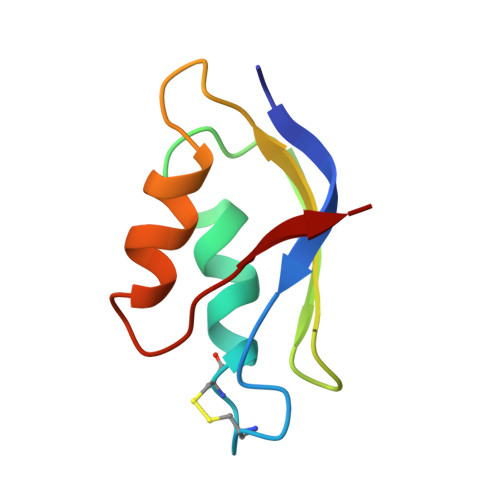NMR solution structure of the oxidized form of MerP, a mercuric ion binding protein involved in bacterial mercuric ion resistance.
Qian, H., Sahlman, L., Eriksson, P.O., Hambraeus, C., Edlund, U., Sethson, I.(1998) Biochemistry 37: 9316-9322
- PubMed: 9649312
- DOI: https://doi.org/10.1021/bi9803628
- Primary Citation of Related Structures:
2HQI - PubMed Abstract:
Mercuric ions are toxic to living organisms because of their strong affinity for cysteine residues in proteins. Some bacteria have developed a resistance mechanism whereby Hg2+ is transported into the cytoplasm and reduced to Hg0. One of the proteins involved in the transport of mercuric ion is the periplasmic binding protein MerP, which can exist both as oxidized (disulfide) and as reduced (dithiol) forms. Only the reduced form with Cys-17 and Cys-14 residues as free thiols is a potent receptor for mercuric ion. In this work the solution structure of the oxidized form of MerP has been determined by multidimensional NMR spectroscopy and compared to the NMR structures of the previously published structures of the reduced and mercury-bound forms of MerP. The mercury-bound and oxidized forms have similar tertiary structures, whereas in the reduced form there is a large rearrangement of the mercuric ion binding loop and the nearby loop comprising residues 38-41. The structural arrangement of the latter loop seems to be important for the stabilization of the surface location of the cysteine-containing loop. In the reduced form at low pH the cysteine-containing loop adopts a conformation similar to what is observed in the oxidized and mercury-bound forms. The oxidized form also differs with respect to the other two forms in the relative positions of some of the alpha-helices and beta-strands. Structural differences between the oxidized and reduced forms may help explain why the reduced form is stable in the periplasm, which is considered to be an oxidizing environment.
- Department of Organic Chemistry, Umeå University, Sweden.
Organizational Affiliation:
















